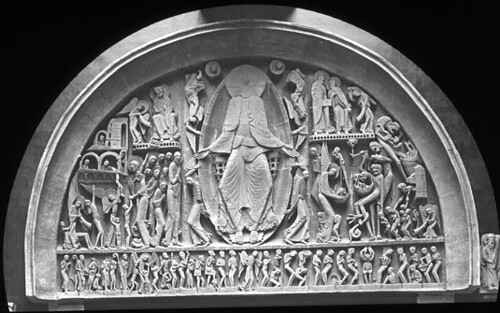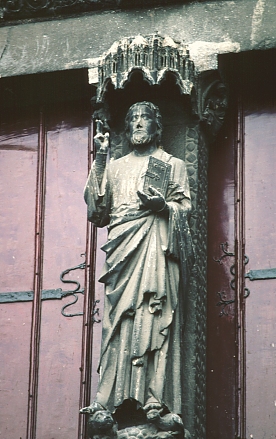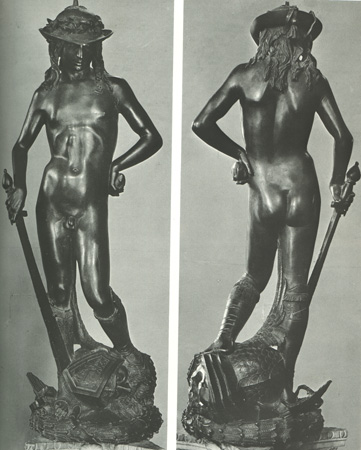pieces clearly demonstrate how the changes from each era relate to varying notions about art
and its uses during those specific periods. A prime example is analyzing the changes in sculpture
and its meaning from the Romanesque period of the twelfth century to the seventeenth century.
The beginning of the twelfth century marked the clearance and survival of the first millennium. Prior to the millennium much fear was generated of the second coming and the end of life. After the survival, a mass religious rebirth spawned. This included a wave of faith and pilgrimage, and undertaking to remove the Muslims, and more intensive religi ous activity. Hence, an enormous amount of churches and cathedrals were built to house pilgrims. Unfortunately the religious outlook was somewhat pessimistic, and dark. This is best displayed in Last Judgment, a tympanum on the Saint Lazare Cathedral at
ous activity. Hence, an enormous amount of churches and cathedrals were built to house pilgrims. Unfortunately the religious outlook was somewhat pessimistic, and dark. This is best displayed in Last Judgment, a tympanum on the Saint Lazare Cathedral at
During the Gothic period the religious atmosphere seemed to lighten up, and an overall optimistic perspective o n religion, a true revival. The early gothic style is fashioned in Beau Dieu, a trumeau statue of the central doorway on the west façade, of the Amiens Cathedral. Here the idea is seen as a loving beautiful God. Christ is the old pantacrator, giving the blessing gesture. Although he is still not contrapossto, Christ does seem to be more open and contain expression and meaning in comparison to Romanesque. But a sculpture that more fully emphasizes the expression of art and learning during the Gothic period is the Virgin and Child of Notre Dame. Mary is sculpted as the Queenly M
n religion, a true revival. The early gothic style is fashioned in Beau Dieu, a trumeau statue of the central doorway on the west façade, of the Amiens Cathedral. Here the idea is seen as a loving beautiful God. Christ is the old pantacrator, giving the blessing gesture. Although he is still not contrapossto, Christ does seem to be more open and contain expression and meaning in comparison to Romanesque. But a sculpture that more fully emphasizes the expression of art and learning during the Gothic period is the Virgin and Child of Notre Dame. Mary is sculpted as the Queenly M adonna and is dressed with the appearance of a French queen. Her body is more relaxed and is elongated with a hip thrust to support Christ, also know as the gothic sway. She serves as an important symbol of guidance and protection. This all shows the more loving delightful positive feeling of religion, and how art was used in a positive way to enhance learning and security. This statue shows more expressive feeling and is also more convincing.
adonna and is dressed with the appearance of a French queen. Her body is more relaxed and is elongated with a hip thrust to support Christ, also know as the gothic sway. She serves as an important symbol of guidance and protection. This all shows the more loving delightful positive feeling of religion, and how art was used in a positive way to enhance learning and security. This statue shows more expressive feeling and is also more convincing.
Moving into the Renaissance we can see a great leap of innovation once again. With Donatello’s David, we see that the relaxed classical contrapposto stance has been rediscovered; also his proportions are of Greek origin. Most importantly is that David is the first  nude figure since ancient times. This specific nudity is seen as bold and heroic, not frail and vulnerable like before. His body shows hints of anatomical interest. While the story of David and Goliath is biblical, David is also a symbol of the independent Florentine republic. This statue shows many of the details and expression of the renaissance, ar
nude figure since ancient times. This specific nudity is seen as bold and heroic, not frail and vulnerable like before. His body shows hints of anatomical interest. While the story of David and Goliath is biblical, David is also a symbol of the independent Florentine republic. This statue shows many of the details and expression of the renaissance, ar tists were once again using art to evoke the senses, while still having political and religious value. In the High renaissance Michelangelo’s David, is as captivating as Ancient Greek and Ancient Roman sculpture. Although larger than life his nude body shows understanding of movement and anatomy. His emotion is in his body and his Hellenistic looking face. This evokes the senses and awareness of what he is doing and what he might be seeing.
tists were once again using art to evoke the senses, while still having political and religious value. In the High renaissance Michelangelo’s David, is as captivating as Ancient Greek and Ancient Roman sculpture. Although larger than life his nude body shows understanding of movement and anatomy. His emotion is in his body and his Hellenistic looking face. This evokes the senses and awareness of what he is doing and what he might be seeing.
Into the seventeenth century we can now experience baroque art. By now all technique is mastered, and artists are involved in involving the viewer. In Gernini’s The Ecstasy of Saint Teresa, our senses are evoked by the technique of using other sources of lighting, the rods of light coming with the angel and the sensation that the sculpture is hovering. We ourselves our wrapped up as if in Teresa’s drapery and can understand the sense of some kind of erotic emotion. Bernini has blurred the lines of seeing a real view point, it is not ideal because what matters is the viewer.
Overall, the length from the Romanesque to the baroque is remarkable. A complete revival of the senses, statues move from solely being a religious and rigid use, to being provocative, incredible technique, and used in learning and teaching as well.



2 comments:
I can't believe the pornography on this blog. I think that I have to talk to my Bishop every time I come to this site. --Commander Cool--
hahahaahahahahahaha I really don't even know what to say
Post a Comment